Don't wanna be here? Send us removal request.
Note
What’s all this inversion stuff about??
so! the aspect wheel, yeah?? provided to us by whatpumpkin on the extended zodiac page:
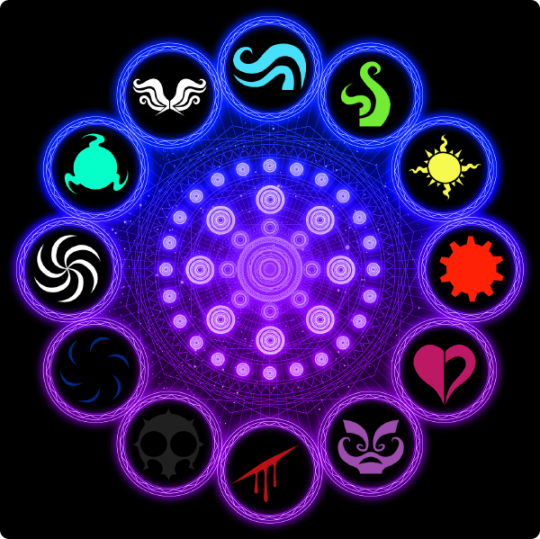
every aspect has a mirror on the opposite side of the wheel that we generally consider to be the “inverse” of that aspect. its the opposite side of the coin, essentially. where breath is about freedom, blood is about bonds, where light is about knowledge, void is about the unknowable, etc.

in canon, when rose goes grimdark, it is generally agreed by people interested in aspect meta that her governing aspect inverted from light to void. it makes a lot of sense that coming under the influence of the gods of the furthest ring would pull one into the void aspect, since they are powerful gods of void, themselves.
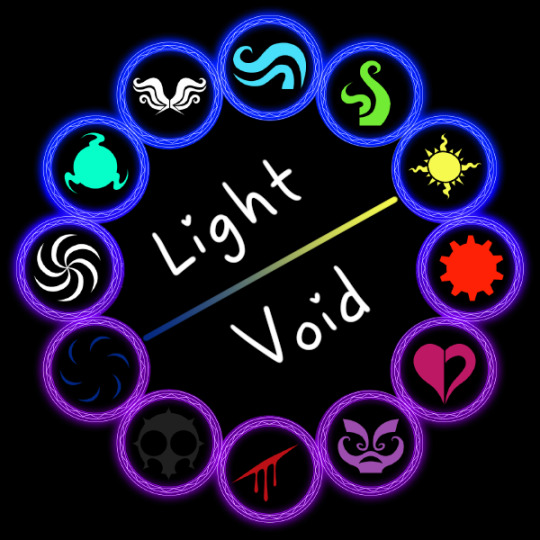
when i sat down with mod strider and really thought about the functionality of aspect and the effect of the gods of void on a player, our conclusion was that it would make more sense for inversions only to happen in instances in which the inverted aspect was closer to void on the aspect wheel than the players native aspect. so breath would invert to blood, but doom would not invert to life, and void does not invert to light.
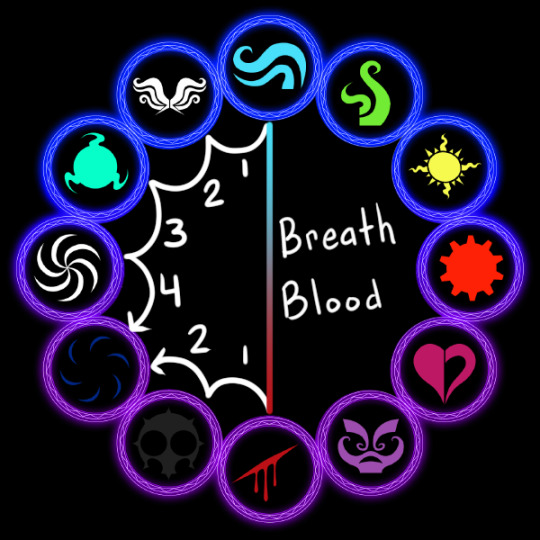
however! we dont believe that the inverted aspect would completely overtake the native aspect in every instance. a new servant of the gods of the furthest ring would be a whole lot more useful and formidable if they were well-rounded-- specifically if their native aspect and its inverse “stacked,” giving them control over both sides of the coin. a seer of light “seeing everything that is and everything that is not“. or a page of breath with domain over both detachment and attachment.
55 notes
·
View notes
Note
do you do classpect descriptions??
if you mean the individual/personalized ones then, unfortunately, no
i tend to stick more to overarching themes as-seen in canon (and not even really that atm due to health issues)
but if someone else wanted to base their classpect descriptions on my interpretation of canon im totally cool with that (just credit me)
0 notes
Text
Classpect Test: More Info, Pt.2
In the previous info post I covered the classes and my notes on them from the classpect test found here. In this post I’ll be discussing the aspects and the notes I gathered from the second half of the test.
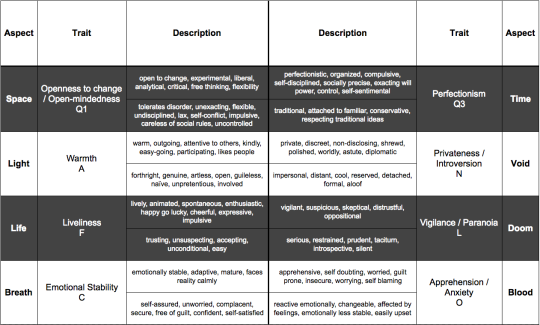
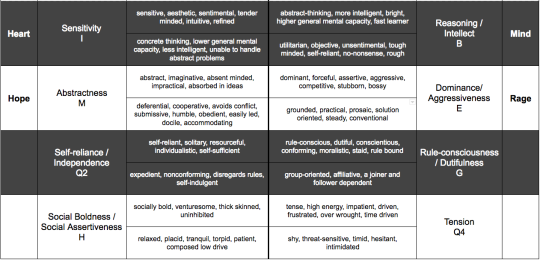
The data in the chart above came from information on the cattell 16 factor test here and here, with the bulk coming from the first link.
Trait Pairs
Normally each trait has a letter associated it (for organizational purposes) and two sets of words that describe the trait. The first set describes people with a high value in that trait, while the second describes the features of those with a low value in that trait. For the purposes of the classpect test this set-up was modified somewhat.
For the classpect test and in the chart above the traits were paired up into loose opposites and then the two sets of descriptions for each trait were split between them. The high value stayed with the trait it came from, while the low value migrated to the opposite trait. Or, put more simply, the low value of one trait is paired with the high value of its opposite trait. In this way each trait and its opposite informed the expression of that trait.
For instance, someone with a low Warmth (A) value would be impersonal, cool, and reserved. They would also be discreet, shrewd, and diplomatic according to the high value of the paired trait, Introversion (N). To make this easier to understand, both of those descriptions are placed on the same side of the chart.
A Note on Descriptions
While most descriptions are morally neutral, some are less flattering than others. This does not mean that those who are dominant in that trait are bad or stupid or any other negative statement that might be implied. The words here were simply pulled directly from the sources linked under the chart and have all their flaws intact.
I will be covering class and aspect descriptions in the context of homestuck in a later post and will include something similar to the chart above. It will hopefully be less...unflattering.
Connection to Homestuck
Finally each trait pair was connected to the aspect pair that best fit it. However, some canon examples of each trait (namely Heroes of Light, because of course they would be difficult) seem to defy the descriptions associated with them on the chart. This discrepancy was the cause of the split in instructions at the end of the classpect test as seen in the chart below.

The classes on the red side of the chart tend to match their aspect in canon so I represented this in the test by having them match their aspect when they are “healthy” (at 1-4 in development), and “invert” when they are “unhealthy” (at 5-9 in development).
The classes on the green side of the chart tend to naturally “invert” their aspect in canon, which I represented by switching which score range was is used to determine the aspect from the ones on the red side.
Inversion Theory???
As I just implied these tests do make some use of inversion theory. Love it or hate it, I think there is some value to it and will be covering my thoughts on it in a later post.
26 notes
·
View notes
Text
Classpect Test: More Info, Pt.1
In the process of making the classpect test found here I collected a metric fuckton of data I realized most people wouldn’t care about. So instead of posting it all at once, I separated it into the test post (linked above) and some information posts.
So lets get started!
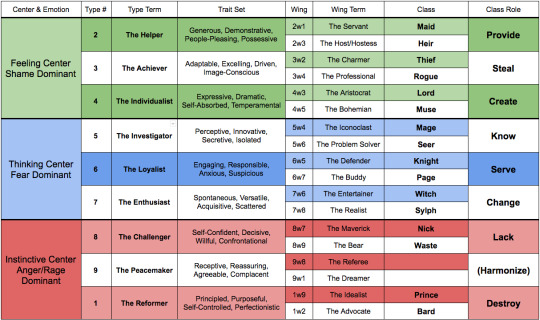
The chart above was made from the info on the enneagram system and the specific details of each enneagram type, which I found here and here.
Centers & Emotion
The first column splits the types and classes into 3 categories: the Feeling Center, the Thinking Center, and the Instinctive Center. Each center is named for how the people in that center tend to interact with and organize the world.
Feeling center people tend to organize the world through their emotional response to it. Thinking center people organize by facts and patterns. Instinctive center people organize by the gut reactions they experience.
Each center also has a dominant emotion that drives the people in that center to act, react, and grow. The Feeling center is driven by shame, Thinking by fear, and Instinctive by anger and rage. While people from all categories experience these emotions, the ones in each center are more prone to being challenged by their associated emotion.
Types, Traits, and Wings
Each of the 9 enneagram types have certain traits associated with them and an overall term used to collectively refer to them (other than the type number).
Each type is also split into 2 subtypes called Wings. These subtypes are notated in the format of “Main Type # - wing - Secondary Type #”, or #w#. One wing is connected to the enneagram type before it, the other to the type after it.
Each person has traits form their main type but also from the type indicated in their wing. So someone who is 6w5 would have the traits of type of 6 but also have traits from 5.
Each wing also has an overall term to refer to those who are of that type.
Connections to Homestuck
As you can see the wing terms are eerily similar to certain classes of homestuck. These similarities go beyond just the terms though, the traits of each type also fit the general personalities of canon characters who are of the associated class.
This was how I initially grouped each class with a type and wing. I only found out about the similarity of wing terms and classes when I made the chart above to help double-check my notes.
In my next post I’ll go over the Aspect part of the test.
31 notes
·
View notes
Text
Classpect Title Test
This is a modified version of the classpect title test by thepageofhopes. The purpose is to give you a Class and Aspect based off your results in personality tests. The classspects used here are as canon as possible, but some gaps are [going to be] filled with theorized ones.
Step 1: Class Test
Take the Enneagram Test found here. Note your Type # and Wing. The result you are looking for will look like #w#. Example: 6w5.
Find your Type # on the center column on the chart below, then find your Wing. The class next to it is your Sburb Class. If there is a tie, pick the one that sounds most like you or that you like the best. Keep the enneagram type information for later.
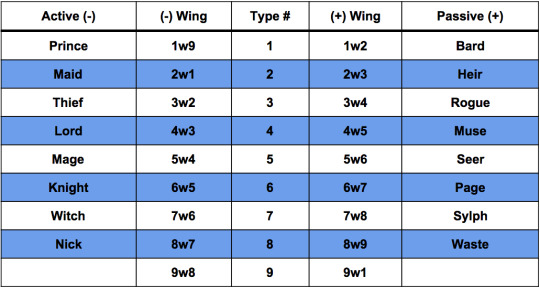
Step 2: Aspect Test
Take the Cattell 16 Factor Test here. You will get a list of data with bars and percentages next to them. You only need to keep track of the percentages for all of these, not the bars. But you will need to convert some of the percentages to get an accurate result from this test.
Step 3: Converting Results
First plug your Tension (Q4) test result into the following equation and note the new result:
100% - Tension% = New Tension%
Then plug your Apprehension / Anxiety (O) into the following equation and note the new result:
100% - Anxiety% = New Anxiety%
Step 4: Finding Relevant Data
Next look at your new list of resulting percentages. Keep the highest and lowest scores and their associated traits. You can discard the rest. If there is a tie for either, keep both for now.
For example, if your lowest score is a tie between Anxiety 10% and Liveliness 10%, you would keep both as your lowest score until the end of the test.
Step 5: Levels of Development
Next you will need to go here and read the description of your Enneagram type from the Class section of the test above. Part way down the page on your type will be a section called Levels of Development. Read them carefully and pick the one that fits you best as you are right now. Then follow the instructions on the chart below.
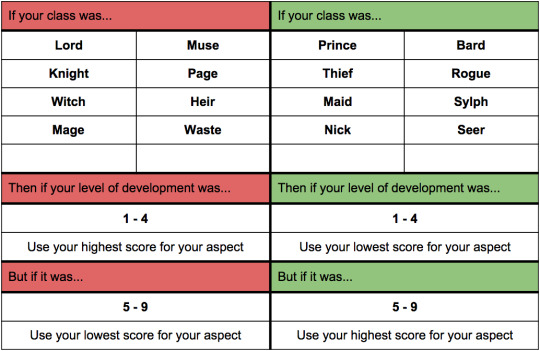
Step 6: Finishing Up
Once you know which score to use, find it on the chart below. In the case of a tie, find both on the chart and pick the one that fits you best.
For a better description of each trait look here. Remember that the description of the opposite range of the paired trait also applies to you. Example: a Life player in the low range would also have traits from the high range in Doom.
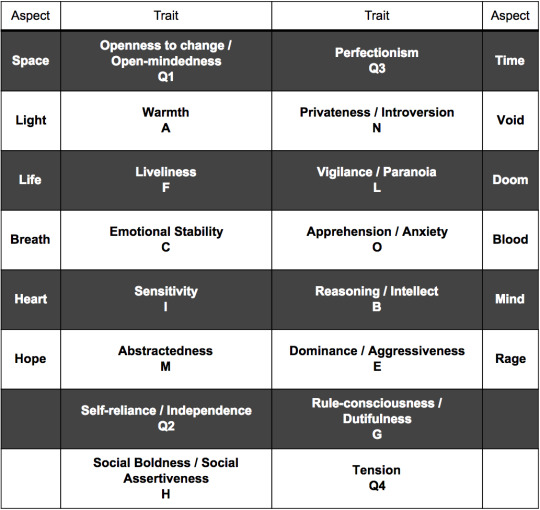
And with that, you’re done!
Remember that this is all for fun so if you don’t like the results you can always ignore it and pick what you like best.
I’ll be posting a more in-depth description of the classes and aspects using this method next.
I will also update this post when I figure out what to put in the non-canon slots.
175 notes
·
View notes
Text
Homestuck Theory Sythesis is now Open!
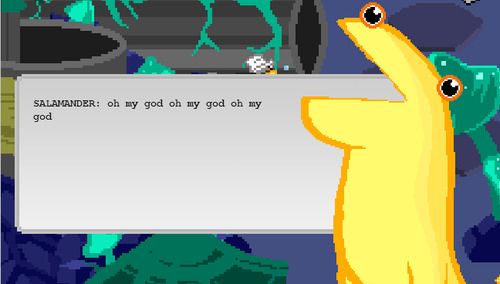
6 notes
·
View notes